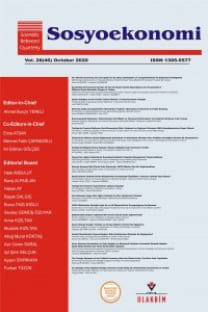İran’da Vergi Şoklarının GSMH ve Enflasyon Üzerindeki Etkisinin Dinamik Stokastik Genel Denge Yaklaşımı ile Analizi
Vergi Şoku, Tüketim Vergisi, İthalat Vergisi, Dinamik Stokastik Genel Denge Modeli
The Effects of Tax Shocks on GNP and Inflation in Iran, A DSGE Approach
___
- Aghion, P. & P. Howitt (1996), “Research and development in the growth process”, Journal of Economic Growth, 1(1), 49-73.
- Alesina, A. & S. Ardagna (2010), “Large changes in fiscal policy: Taxes versus spending”, Tax Policy and the Economy, 24(1), 35-68.
- Arnold, J.M. et al. (2011), “Tax policy for economic recovery and growth”, The Economic Journal, 121(550), 59-80.
- Barro, R.J. & C.J. Redlick (2011), “Macroeconomic effects from government purchases and taxes”, The Quarterly Journal of Economics, 126(1), 51-102.
- Chapardar, A. & Gh. Garaei Nejad (2012), “Investigating the factors affecting tax revenues in Iran”, Financial Economics Quarterly, 6(20), 69-92.
- Correia, I.H. (1996), “Should capital income be taxed in the steady state?”, Journal of Public Economics, 60(1), 147-151.
- Dahlby, B. & E. Ferede (2012), “The impact of tax cuts on economic growth: Evidence from the Canadian provinces”, National Tax Journal, 65(3), 563-594.
- Fotros, M. & A. Dalaei Milan (2016), “Investigating the underground economy and tax evasion in the framework of Dynamic Stochastic General Equilibrium Models”, Economic Growth and Development Research, 7(25), 65-84.
- Gemmell, N. et al. (2011), “The timing and persistence of fiscal policy impacts on growth: Evidence from OECD countries”, The Economic Journal, 121(550), 33-58.
- Grossman, G.M. & E. Helpman (1991), “Quality ladders in the theory of growth”, The Review of Economic Studies, 58(1), 43-61.
- Hasanzadeh Jozdani, A. (2016), “Investigating the effect of taxes on GDP and inflation in Iran in the framework of a Dynamic Stochastic General Equilibrium Model”, (PhD) Thesis, Tarbiat Modares University.
- Heidari, H. & L. Saeedpour (2015), “Analysis of the impact of fiscal policy shocks and the growth rate of the Iranian economy in the framework of the New Keynesian model”, Economic Growth and Development Research, 5(20), 61-78.
- Jones, C.I. (1995), “R&D-based models of economic growth”, Journal of Political Economy, 103(4), 759-784.
- King, R.G. & S.T. Rebelo (1989), “Transitional dynamics and economic growth in the Neoclassical Model”, American Economic Review, 83(4), 908-931.
- Mendoza, E.G. et al. (1997), “On the ineffectiveness of tax policy in altering long-run growth: Harberger's superneutrality conjecture”, Journal of Public Economics, 66(1), 99-126.
- Mertens, K. & M.O. Ravn (2013), “The dynamic effects of personal and corporate income tax changes in the United States”, American Economic Review, 103(4), 1212-1247.
- Mirmohammadi, S.M. & N. Jannati (2016), “Investigation the statue of the tax system during 2005-2015 in Iran”, Journal of Engineering and Applied Sciences, 11(14), 3248-3253.
- Pajooyan, J. & B. Darwish (2010), “Structural reforms in the Iranian tax system”, Journal of Taxation, 18(8), 9-48.
- Pecorino, P. (1994), “The growth rate effects of tax reform”, Oxford Economic Papers, 492-501.
- Rostami, M. & S.N. Makiyan (2019), “Bayesian Unit Root Test in terms of pert observations: A case study of the daily returns of 50 active companies of Tehran Stock Exchange”, Econometric Modeling, 4(3), 59-86.
- Zhou, X. (1992), “Optimal fiscal policy in a stochastic growth model”, Journal of Economic Theory, 58(2), 250-289.
- ISSN: 1305-5577
- Yayın Aralığı: Yılda 4 Sayı
- Başlangıç: 2005
- Yayıncı: Sosyoekonomi Derneği
Metaverse Kullanıcı Kabulü: Teknoloji Kabul Modeli (TKM) Çerçevesinde e-Ticaret Üzerine Bir Analiz
Yavuz TORAMAN, Barış Batuhan GEÇİT
Kayıt Dışı Ekonomi ve Finansal Gelişme: Kurumların Rolü
Vergi Cezaları Açısından Çerçeveleme Kuramı: Türkiye-Rusya Örneği
Tutcu BURÇİN, Günay Deniz DURSUN, Hasan TALAŞ
Türkiye’de Dolaylı Vergi Yükü ve Dolaylı Vergilerin Artan Oranlılığı
Uğur AKKOÇ, Selçuk GEMİCİOĞLU, Burça KIZILIRMAK
Hizmet İhracatı ile Ekonomik Büyüme İlişkisinin Güney Kafkas Ülkeleri Çerçevesinde Analizi
Eser ÇAPIK, Hidayet Gizem ÜNLÜ ÖREN
Kamu Borç ve Yatırımları Türkiye’de Dışlama Etkisi Yaratır mı? ARDL Yaklaşımından Kanıtlar
Güvenlik İklimi ve Güvenlik Performansı Göstergeleri Arasındaki İlişki: Bir Alan Araştırması
Enflasyon ve Soğuk Artan Oranlılık: 2006-2021 Dönemi İçin Türk Gelir Vergisi Üzerine Bir İnceleme
